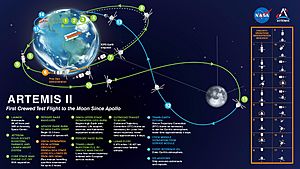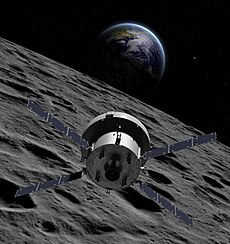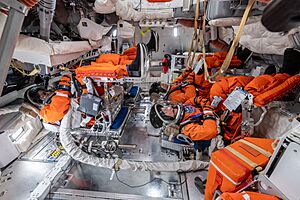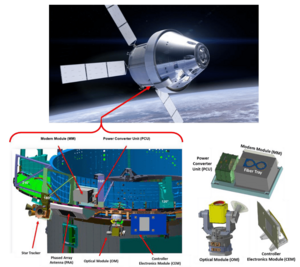Artemis II facts for kids

The Orion spacecraft and its European Service Module for the Artemis II mission. The mission is planned to launch in April 2026.
|
|
| Names |
|
|---|---|
| Mission type | Crewed lunar flyby |
| Operator | NASA |
| Mission duration | 10 days (planned) |
| Spacecraft properties | |
| Spacecraft | Orion CM-003 |
| Crew | |
| Crew size | 4 |
| Members | |
| Start of mission | |
| Launch date | NET April 2026 |
| Rocket | Space Launch System Block 1 |
| Launch site | Kennedy Space Center, LC-39B |
| End of mission | |
| Recovered by | U.S. Navy (San Antonio-class amphibious transport dock) |
| Landing site | Pacific Ocean (planned) |
| Flyby of Moon | |
| Distance | 6,400 mi (10,300 km) (planned) |
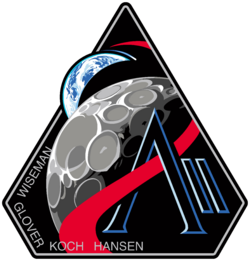 Artemis II mission patch 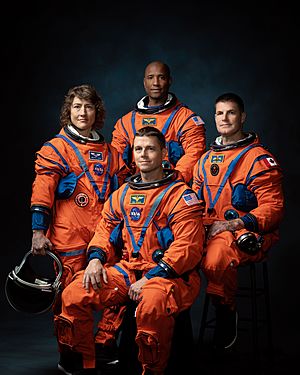 Official crew portrait, clockwise from left: Koch, Glover, Hansen and Wiseman |
|
Artemis II is an exciting, planned space mission led by NASA. It will be the first time astronauts fly on the powerful Space Launch System (SLS) rocket and the new Orion spacecraft. The mission is scheduled to launch no earlier than April 2026.
Four astronauts will travel on a 10-day journey that will take them around the far side of the Moon and back to Earth. This will be the first time people have traveled beyond low Earth orbit and to the Moon since the Apollo 17 mission in 1972.
The mission was first called Exploration Mission-2 (EM-2). The original plan was to visit an asteroid, but this was changed to focus on returning to the Moon as part of the Artemis program.
Contents
The Crew of Artemis II
The Artemis II mission will have a crew of four astronauts. They were announced to the public on April 3, 2023.
| Position | Astronaut | |
|---|---|---|
| Commander | Second spaceflight |
|
| Pilot | Second spaceflight |
|
| Mission Specialist 1 | Second spaceflight |
|
| Mission Specialist 2 | First spaceflight |
|
| Position | Astronaut | |
|---|---|---|
| Mission Specialist | ||
| Mission Specialist | ||
This crew will make history. Victor Glover will be the first person of color, Christina Koch will be the first woman, and Jeremy Hansen will be the first non-American to fly to the Moon. Hansen is an astronaut from the Canadian Space Agency.
The Mission Plan
The Artemis II mission will send four astronauts on a trip around the Moon. They will not land, but they will fly farther from Earth than any human has gone before. The mission will test the Orion spacecraft to make sure it is safe for future missions that will land on the Moon.
The journey is planned to last about 10 days and will follow several steps.
Launch and First Orbit
The powerful SLS rocket will launch the Orion spacecraft from Kennedy Space Center in Florida. After about eight minutes, Orion will be in a temporary orbit around Earth.
The rocket's upper stage will then fire again. This will push Orion into a very high orbit that takes about 24 hours to complete. During this time, the crew will check all of Orion's systems to make sure everything is working perfectly.
Journey to the Moon
After the system checks are complete, Orion will fire its own engines. This powerful burn will send the spacecraft out of Earth's orbit and on a path toward the Moon.
This part of the trip will use a special path called a free-return trajectory. This means that once Orion is on its way, the Moon's gravity will naturally pull the spacecraft around it and send it back toward Earth. This is a safety feature in case the engines have a problem.
Flying Around the Moon
The crew will fly around the far side of the Moon, seeing a view that very few people have ever seen. At its closest point, Orion will be about 7,400 kilometers (4,600 miles) from the lunar surface.
During the flyby, the astronauts will continue to test Orion's systems. They will also gather information about what it's like to travel in deep space, far from Earth's protection.
Return to Earth
After swinging around the Moon, Orion will head back home. When it reaches Earth, the spacecraft will separate from its service module, which provides power and supplies. The crew capsule will then enter Earth's atmosphere at very high speed.
A large heat shield will protect the capsule and the crew from the intense heat of re-entry. Finally, huge parachutes will open to slow the capsule down for a gentle splashdown in the Pacific Ocean, where a U.S. Navy ship will be waiting to recover the crew and spacecraft.
Mission Technology
Laser Communications
Artemis II will test a new way to communicate from deep space using lasers. This system is called O2O, which stands for Orion Artemis II Optical Communications System.
Instead of just using radio waves, O2O will send information back to Earth as beams of light. This allows data, like high-definition video, to be sent much faster than with current systems. The signals will be sent to special ground stations in California and New Mexico.
Small Satellites
Artemis II will also carry five small satellites, called CubeSats, from different countries. These satellites will be released into space after Orion has separated from the rocket.
These small missions will conduct their own science experiments in high Earth orbit. They will study things like the effects of space radiation on electronics and test new technologies for future missions. This is part of an effort to include more countries in space exploration through the Artemis Accords.
Building the Rocket
Getting the giant Space Launch System (SLS) rocket ready has been a huge job. The main part of the rocket, called the core stage, was built at a NASA facility in New Orleans.
After the four powerful RS-25 engines were installed, the core stage was shipped by barge to the Kennedy Space Center in Florida in July 2024.
The launch was originally planned for an earlier date. However, engineers needed more time to study issues with Orion's life support system and its heat shield, which was damaged more than expected during the Artemis I test flight. After careful review, NASA announced in December 2024 that the launch was planned for April 2026 to ensure everything is safe for the crew.
Similar Missions
The Artemis II mission is similar in some ways to the Apollo 8 mission in 1968. The Apollo 8 crew also flew to the Moon without landing. However, they went into orbit around the Moon ten times.
Artemis II's flight path is more like the Apollo 13 mission from 1970. That mission had a serious problem on the way to the Moon, and the crew had to use a free-return trajectory to swing around the Moon and get back to Earth safely.
See also
 In Spanish: Artemis 2 para niños
In Spanish: Artemis 2 para niños
- List of Artemis missions
- List of missions to the Moon



